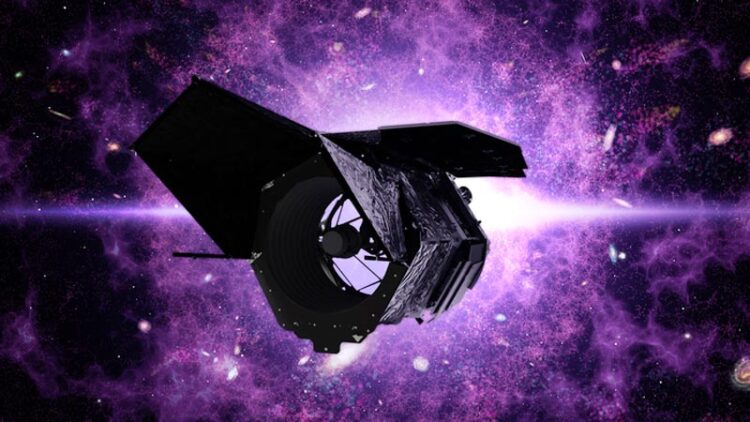‘Planet confusion’ could slow Earth-like exoplanet exploration

Artistic rendering of the Nancy Grace Roman Space Telescope, currently under development by NASA, which will be used in the search for distant planets beyond our solar system.
Credit: NASA/Provided
When it comes to directly imaging Earth-like exoplanets orbiting faraway stars, seeing isn’t always believing. A new Cornell University study finds that next-generation telescopes used to see exoplanets could confuse Earth-like planets with other types of planets in the same solar system.
With today’s telescopes, dim distant planets are hard to see against the glare of their host stars, but next-generation tools such as the Nancy Grace Roman Space Telescope, currently under development by NASA, will be better at imaging Earth-like planets, which orbit stars at just the right distance to offer prime conditions for life.
“Once we have the capability of imaging Earth-like planets, we’re actually going to have to worry about confusing them with completely different types of planets,” said Dmitry Savransky, associate professor of mechanical and aerospace engineering and of astronomy.
“The future telescopes that will enable these observations will be so huge, expensive, and difficult to build and launch that we can’t afford to waste a single second of time on them,” Savransky said, “which is why it is so important to think through all of these potential issues ahead of time.”
By using Earth’s own solar system as a model of an unexplored star system, Savransky and doctoral student Dean Keithly, calculated that even with direct-imaging techniques and the increased capabilities of future, high-powered telescopes, exoplanets as different as Uranus and Earth could be mistaken for one another.
The research details how measurements estimating planet-star separation and brightness can cause “planet confusion.” The modeling finds that when two planets share the same separation and magnitude along their orbits, one planet can be confused for the other.
Keithly and Savransky identified 21 cases within their solar system model in which an individual planet had the same apparent planet-star separation and brightness as another planet. Using this data, it was calculated that an Earth-like planet could be misidentified with a Mercury-like planet in 36% of randomly generated solar systems; with a Mars-like planet in about 43% of randomly generated solar systems; and with a Venus-like planet in more than 72% of randomly generated solar systems.
In contrast, confusion between Earth-like planets and larger gas-giant planets similar to Neptune, Saturn and Uranus was less likely, and could occur in 1-4% of randomly generated solar systems.
Confusing planets for one another can be an expensive and time-consuming problem for scientists. Extensive planning and funds go into each use of a high-powered telescope, so the false identification of a habitable exoplanet wastes valuable telescope time. With this problem identified, researchers can design more efficient exoplanet direct-imaging mission surveys.
The researchers warn that further improvements to instrument contrast and inner-working angles could exacerbate the problem and advise that future exoplanet direct-imaging missions make multiple observations to more accurately differentiate between planets.
The research was funded by NASA and published recently in Astrophysical Journal Letters.
For additional information, see this Cornell Chronicle story.
Cornell University has dedicated television and audio studios available for media interviews supporting full HD, ISDN and web-based platforms.
Journal: The Astrophysical Journal Letters
DOI: 10.3847/2041-8213/ac20cf
Media Contact
Becka Bowyer
Cornell University
rpb224@cornell.edu
Office: 607-220-4185
All latest news from the category: Physics and Astronomy
This area deals with the fundamental laws and building blocks of nature and how they interact, the properties and the behavior of matter, and research into space and time and their structures.
innovations-report provides in-depth reports and articles on subjects such as astrophysics, laser technologies, nuclear, quantum, particle and solid-state physics, nanotechnologies, planetary research and findings (Mars, Venus) and developments related to the Hubble Telescope.
Newest articles

Largest magnetic anisotropy of a molecule measured at BESSY II
At the Berlin synchrotron radiation source BESSY II, the largest magnetic anisotropy of a single molecule ever measured experimentally has been determined. The larger this anisotropy is, the better a…

Breaking boundaries: Researchers isolate quantum coherence in classical light systems
LSU quantum researchers uncover hidden quantum behaviors within classical light, which could make quantum technologies robust. Understanding the boundary between classical and quantum physics has long been a central question…

MRI-first strategy for prostate cancer detection proves to be safe
Active monitoring is a sufficiently safe option when prostate MRI findings are negative. There are several strategies for the early detection of prostate cancer. The first step is often a…



